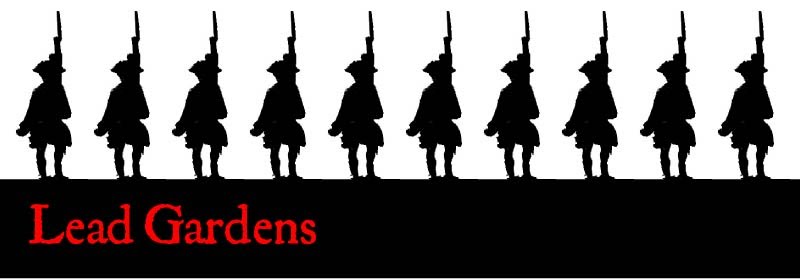These are a few rules variations to Charles Grant's rules published in "The Wargame" They were written to simplify casualty resolution and introduce a card driven turn sequence to make playing solo easier. These rules try to preserve some of the sense of a simultaneous move game and do preserve the tense "do I move a full 7" or just 4 1/2" and fire or hold and wait for them to come" style that make "The Wargame" (or "Charge") so much fun. None of of this is really anything super new but it does work pretty well. I'm really interested in any other modifications that have been tried, particularly in regards to roundshot.
Turn Sequence:
I use a regular deck of 52 cards to "run" the game. Basically I turn a card and red or black indicates which side can select a unit to activate. ( a unit is: a regiment of infantry, squadron of Cav, or an artillery battery commanded by an officer or an individual gun, I also allow a CinC, Brigade commander or a Cavalry regimental Colonel to activate all units within 6" under their command (determined at the beginning of the game). Active units can move, move/fire, melee or charge as per the original rules or the unit can pass (counts as an activation). Units being contacted that have not yet activated or have passed can fire their volley before contact. After a unit performs its activation it is marked and can't do anything until all units of both sides have been activated. When all units of both sides have been marked. I go back and remove the "activated" markers resolving all required morale checks or attempts to rally as I go, marking units that fail (hold or fall back). Then the sequence starts again. I just keep going through the deck without shuffling at the end of the sequence and count an hour of "battle time" each time the deck is exhausted and then reshuffled. At the beginning of the sequence all units from the past sequence that are marked for morale failure must be activated first (when their sides color comes up) and fall back as per Grant, this counts as their activation for that sequence. Pretty simple and as a bonus I can walk away from a game mid sequence and come back to it a week later and know which units can still activate....so the game can pick up right where it left off.
Artillery Fire
Cannister- use the template as per Grant (I just make the guns fire straight ahead and must use up an activation to change their facing.
Shell- use template as per Grant (and jolly good fun it is lobbing shells into forts and such!)
Roundshot- I used the revised roundshot method from the "Charge" rules but find that even with the "over and under dice roll" it almost invariably hits about where you want it and with solo play I don't want to be "aiming" at officers and such... so I'm experimenting with just rolling a D6 for each rank passed through (4" on either side of an aiming point) not counting officers behind the line as a rank or anything like that. After that I turn the card deck for each successful hit and use the following to determine officer casualties:
2-10 = regular soldier
J = minor officer (drummer figure)
Q = subaltern (the fellows with the spontoon)
K = major officer
A = Brigadier if attached or otherwise major officer
Joker = Brigadier or CinC within 6" of target point (this represents the unlucky shot that has the general's name on it.)
Musketry:
As per Grant (1 per 6 line or 4 grenadiers)...except instead of counting heads and numbering the target figures to determine who gets hit (a bit fussy I always thought...) I just re roll 1D6 for each hit and count any duplicates as a single hit. Example:
...rolling 5 D6s (say -2 off the die) and the result is 5 3 6 2 1 1 giving: 8 hits then roll 8d6s for the 8 hits giving: 6 6 4 3 3 1 5 thus if you cancel out the duplicated hits (or a Mr. Grant would say a man hit twice) you get 5 hits. I think it works out about the same as the original rules.
Then you would turn 5 cards as shown above in the roundshot rules to determine any officer casualties...example: 2 5 7 8 J would be four musketeers and a minor officer down.
remember turning cards also essentially "runs the clock" so I don't shuffle till the deck is run through. That way turns with lots of action tend to take up more scale time and gives a simple way of keeping track of the time of the overall battle without resorting to too much. This works fine with small battles but I could see how a really large battle with lots of events would pass through the deck too quickly to make the times work out well.
Melee:
... is as per Grant
The only other rule I've been toying with is that if the Jokers come up (other than during officer casualty determination), you could introduce some sort of special event that would be advantageous to the side whose color comes up on the next card.
All in all, ...really minor changes to an already great game!

2 comments:
Really interesting: thanks for sharing!
Jean-Louis
Dave,
I'll copy what Jean-Louis said . . . since I was about to say:
Thanks for your modifications; they are quite interesting.
-- Jeff
Post a Comment